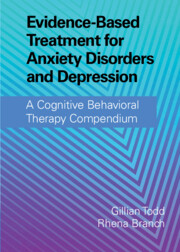 Evidence-Based Treatment for Anxiety Disorders and Depression
Evidence-Based Treatment for Anxiety Disorders and Depression from Part Six - Specialist Applications of Cognitive Behavioral Therapy for Anxiety Disorders and Depression
Published online by Cambridge University Press: 06 January 2022
There is compelling evidence supporting the use of cognitive behavioral therapy (CBT) to treat depression and anxiety disorders; furthermore, recent evidence supports the use of CBT to treat attention-deficit/hyperactivity disorder (ADHD) in adults as well. High comorbidity among these conditions requires healthcare providers to recognize and treat problems with anxiety and depression in adults with ADHD, or ADHD in adults with anxiety and depression. This chapter reviews relevant research on the comorbidity of internalizing conditions in adults with ADHD and provides three guiding principles for tailoring CBT to treat depression and anxiety disorders in adults with ADHD: comprehensive case conceptualization, addressing therapy-interfering behaviors, and a functional approach to cognitive and behavioral avoidance.
To save this book to your Kindle, first ensure no-reply@cambridge.org is added to your Approved Personal Document E-mail List under your Personal Document Settings on the Manage Your Content and Devices page of your Amazon account. Then enter the ‘name’ part of your Kindle email address below. Find out more about saving to your Kindle.
Note you can select to save to either the @free.kindle.com or @kindle.com variations. ‘@free.kindle.com’ emails are free but can only be saved to your device when it is connected to wi-fi. ‘@kindle.com’ emails can be delivered even when you are not connected to wi-fi, but note that service fees apply.
Find out more about the Kindle Personal Document Service.
To save content items to your account, please confirm that you agree to abide by our usage policies. If this is the first time you use this feature, you will be asked to authorise Cambridge Core to connect with your account. Find out more about saving content to Dropbox.
To save content items to your account, please confirm that you agree to abide by our usage policies. If this is the first time you use this feature, you will be asked to authorise Cambridge Core to connect with your account. Find out more about saving content to Google Drive.